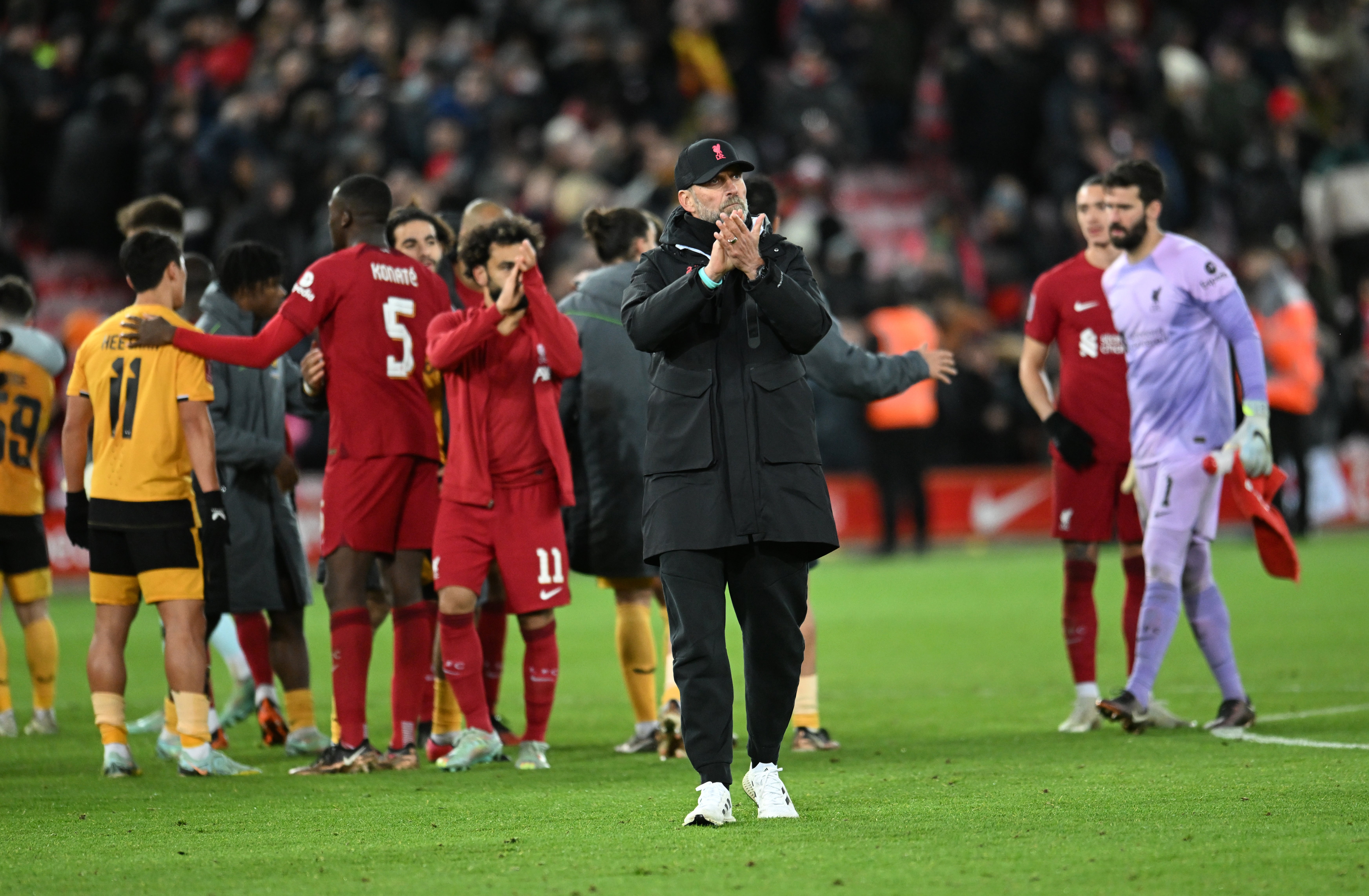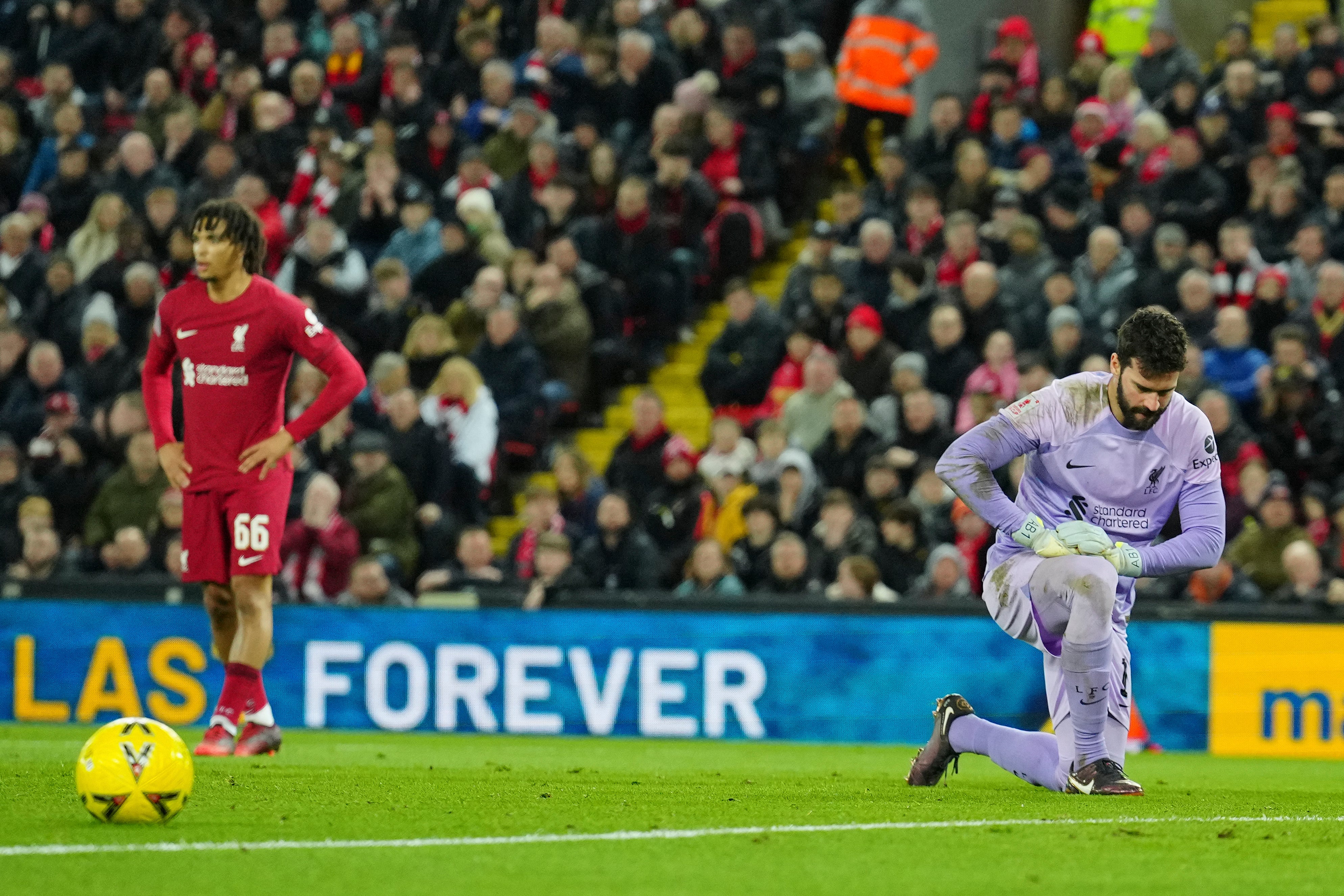
Their identity was intensity. Perhaps not anymore, though. Jurgen Klopp reacted to Liverpool’s flirtation with an early exit from the FA Cup by declaring: “We win not enough challenges; nowhere.” His side were second best to second balls too often against Wolves. Klopp marked his arrival at Anfield by declaring he wanted to make Liverpool “the hardest team to beat” in the world. Last season, when they lost just four of 64 games, they were.
On Saturday, Wolves nearly beat them. Or Liverpool nearly beat themselves; both really. Even with a 2-2 draw, they have their highest percentage of defeats in a season since the campaign before Klopp’s appointment, 2014-15. Losing challenges and losing matches may go hand in hand; so, too, losing the ball.
Klopp once declared that a good counter-press was better than any playmaker, but Liverpool’s sloppiness in possession means they can double up as the playmaker-in-chief for their opposition. Alisson passed straight to Goncalo Guedes for Wolves’ opener and his ball, along with a Harvey Elliott mistake, led to Brentford’s second goal on Monday.
Those misplaced balls can seem a case of standards slipping, of players feeling mentally and physically exhausted after the exertions of recent seasons or examples of teammates in what was a superbly coherent side now feeling on different wavelengths. They mean Liverpool, long the specialists in transition, now feel more liable to concede in such situations.
They can still be the kings of the counter-attack – look at Darwin Nunez’s strike on Saturday, created by Trent Alexander-Arnold with a magnificent pass – but can be caught on the break. In 2019-20, they scored the most Premier League goals on the counter-attack; in 2018-19, they conceded none on it, according to WhoScored statistics. Now only Everton have let in more goals in such situations.
Klopp’s high defensive line can be controversial. For him, the issue lies in tackles. “Ball orientated or man orientated, high line or deeper line, you have to win challenges,” he said. “It is something I mention in the dressing room.”
His tactics could seem a form of chaos theory when his side were at their most raw and visceral; yet the key was that the chaos occurred among the opponents, rattled by Liverpool’s ferocious press, buffeted by their speed and directness. Now, as a host of frenetic displays of flawed entertainment this season show, the chaos is not confined to one end of the pitch.
“It looks open because we think we win a challenge and don’t win it,” Klopp said. His charges are configured to think they will. It is why attack-minded full-backs can be caught upfield, why there can be space in behind them. Liverpool cannot spring quick breaks if they remain behind the ball, assuming it will be lost. It was why it was always simplistic just to blame Alexander-Arnold.

Sooner or later, most discussions about Liverpool come back to the midfield. This is no exception. Over the season, players such as Fabinho, James Milner and Thiago Alcantara are winning a lower percentage of tackles than last season and are making fewer interceptions per 90 minutes than they were last year. Elliott is in effect playing Naby Keita’s minutes and winning the ball less often than the Guinean. It helps explain why Liverpool have become more open.
They do not erect enough roadblocks on the route to goal. Opponents succeed with 45.4 per cent of dribbles in the Premier League against Liverpool; the pertinent part is that it is the second highest and Liverpool have the third-highest number of missed tackles in such situations. There is also the problem of when Liverpool err. They have conceded the first goal in the majority of their games this season.
The team who used to blitz opponents from the start evolved. If all-out assault gave way to something more controlled, now they have lost control too often and end up chasing games, lacking their cohesion and precision.

Jamie Carragher’s argument, that they have morphed from a physical team to a technical one, reflected the shift in style Thiago’s arrival brought. But it is also harder to remain a physical team after transitioning to an older one. At times, the pressing game is supposed to be led by Mohamed Salah and Roberto Firmino, both in their thirties – and Liverpool, who used to top the charts for most tackles in the final third are now near the bottom of it; the second balls are supposed to be won by Jordan Henderson, Thiago and Milner, all in their thirties; the high defensive line is based around Virgil van Dijk and Joel Matip, both in their thirties.
If it is harder for them to produce such intensity, it places a greater emphasis on eliminating errors. Instead, they have increased. And while elite teams, because they tend to have the ball for the majority of the game, have less need to make tackles, it is remarkable that in 2016-17, Klopp’s first full season, they made the second most in the Premier League. Now they have made the second least. It feels like another problem to tackle amid their identity crisis.







